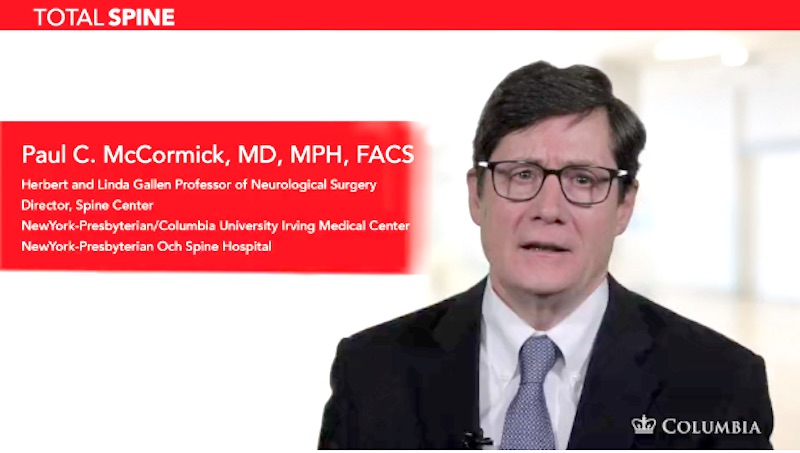If a doctor said you had a type of brain or spinal tumor known as a subependymoma, you’d probably have a lot of questions. And you’d be in good company. Despite first being described in 1945, subependymomas are so rare that for very many decades, little was known about them. Where do they come from? What symptoms do they cause? And what can a patient expect when she learns she has one?
To explore the answers to these questions and others, Columbia University Irving Medical Center/NewYork-Presbyterian Hospital (CUIMC/NYPH) neurosurgeons Dr. Paul McCormick, Dr. Neil Feldstein, Dr. Guy McKhann II, Dr. Michael Sisti, Dr. Jeffrey Bruce, Dr, Alfred Ogden, and neurosurgery resident Dr. Randy D’Amico collaborated with colleagues* to study this rare tumor. They reported their findings in the journal World Neurosurgery.
To understand what the researchers learned, it’s worth knowing some basic information about subependymomas. They’re usually benign tumors (non-cancerous growths that will not spread), and they arise in the lining of special fluid-filled spaces within the brain or spinal cord.
The fluid within these special spaces is known as cerebrospinal fluid(CSF). The CSF’s jobs include delivering nutrients, removing waste products and acting as a fluid “cushion” for the brain and spinal cord.
In the brain, the CSF flows through a series of chambers known as ventricles. Two lateral ventricles are located on the left and right sides of the brain; the third ventricle is located between them. Below the third ventricle, near the base of the brain, is the fourth ventricle. Below the fourth ventricle is a hollow channel in the spinal cord known as the central canal. The ventricles and the central canal are all connected, and CSF normally flows freely through them.
Subependymomas always appear in the lining of the ventricles or the central canal. But they cause a huge range of symptoms. A subependymoma’s symptoms generally arise when the tumor interferes with nearby structures—either compressing the nearby tissue of the brain or spinal cord, or blocking a certain portion of the CSF flow. So the researchers had a pretty good idea that a tumor’s symptoms would depend on its location. To get hard data, they reviewed the CUIMC/NYPH medical records of 31 individuals with subependymomas between the years 1998 and 2006.
They found that patients with subependymomas in the fourth ventricle tended to show up with a main symptom of nausea, whereas those with lateral ventricle tumors had more difficulty with mental functioning and walking.
Patients with subependymomas in the central canal tended to have back pain or symptoms related to compression of the nerves that arise from the spinal cord. This latter condition, known as radiculopathy, could affect muscle strength, sensation and/or bladder function.
However, seven of the 31 patients in the study were never even diagnosed with subependymoma during their lifetimes. They had no known symptoms, they died from unrelated causes and their tumors were found only on autopsy. Their tumors were of a size, and in a location, that did not impede CSF flow or compress nearby structures. Thus, sometimes a subependymoma may be present but cause no symptoms at all.
In addition to the patients’ symptoms, the authors were interested in finding out what cells the subependymomas originally came from. A tumor forms when a normal cell mutates and replicates. But even the mutated cells still retain some traits that have to do with their original function and location. This allows doctors to figure out where tumor cells originally came from.
There are two ways that pathologists identify tumor cell types: using stains and looking at markers.
A stain is like a dye that allows pathologists to see more detail in a tumor’s cells under a microscope.
A marker is a specific protein on the surface of the cell. Markers serve as sort of “name tags” for different cell types: just as someone might wear a badge at a meeting to tell others where she is from, the marker on the cell surface tells us about the cell’s origin.
The pathologists of the 31 tumors in the study used stains and markers to find out about each tumor’s origin. The researchers found that, overall, subependymomas have the characteristics of two primary cell types: glial cells and stem cells.
Glial cells normally provide a structure that supports the brain’s nerves. Stem cells are best described as immature cells that can develop into a number of different cell types. Knowing the cell types of origin helps researchers begin to understand how and why subependymomas develop.
The 24 patients with subependymomas that caused symptoms all had their tumors removed. All tumors were removed safely, none of the tumors had spread and none of the tumors recurred. This is great news for patients with subependymoma. However, patients currently cannot be diagnosed with a subependymoma until after the surgery to remove it. Diagnosis requires that a pathologist examine the cells of the tumor; imaging tests cannot currently distinguish between a subependymoma and a more aggressive tumor.
Identifying the cell types and locations of origin of subependymomas takes us a few steps closer to better diagnosing and treating patients with this rare disease. This kind of research is well suited to large medical centers like Columbia, for a couple of reasons. First, there are a variety of specialists under one roof, each with expertise that contributes to the discussion. (The authors of this study included experts in brain surgery, spinal surgery and surgical pathology. All of them had some experience with subependymoma, which is rare.) Second, it’s important to be able to look at enough patients with the condition to begin to answer questions about it.
And the more answers researchers and physicians have, the better they can diagnose, plan treatment and advise patients on what to expect.
Learn more about Dr. McCormick on his bio page here.



